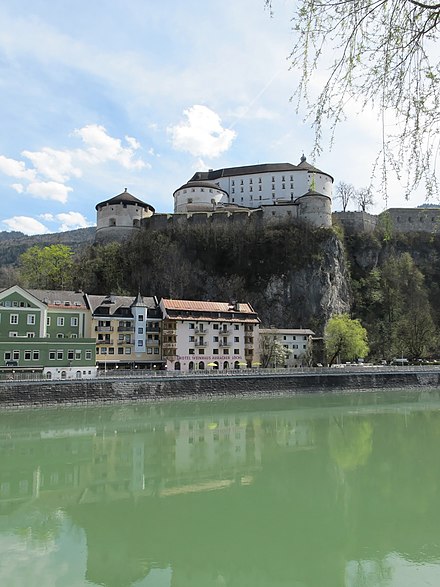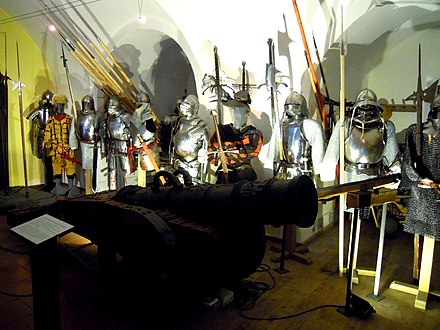Kufstein - municipality in Kufstein District, Tyrol, Austria
 Kufstein is city in the Austria state of Tyrol, with a population of ca. 18,000 inhabitants, making it the second largest city in Tyrol after its capital Innsbruck. On the west, Kufstein is flanked by the Brandenberg Alps. The Kaiser mountains lie to the south-east. The valley between the two is called the Inntal (Tal in German is Valley) and is where Kufstein is located. Most travellers visiting the Austrian Alps pass through Kufstein either by train, coach or car as it is the first city south of the German border at the end of the Inntal. Kufstein is known for its fortress, and is also associated with one of the best known German folk songs - the Kufstein song - which rose to popularity in the 1960s.
Kufstein is city in the Austria state of Tyrol, with a population of ca. 18,000 inhabitants, making it the second largest city in Tyrol after its capital Innsbruck. On the west, Kufstein is flanked by the Brandenberg Alps. The Kaiser mountains lie to the south-east. The valley between the two is called the Inntal (Tal in German is Valley) and is where Kufstein is located. Most travellers visiting the Austrian Alps pass through Kufstein either by train, coach or car as it is the first city south of the German border at the end of the Inntal. Kufstein is known for its fortress, and is also associated with one of the best known German folk songs - the Kufstein song - which rose to popularity in the 1960s.
Understand
Get in
By train
Kufstein can easily be reached by train, with the Kufstein railway station, 47.583056°, 12.165833°. being a local railway hub. The station is served by local, InterCity, ICE and Railjet trains.
By plane
Kufstein-Langkampfen Airport, Kufsteiner Str. 42, A-6336 Langkampfen (ca. 3 km to the south west of the city centre), 47.5656°, 12.1275°, +43 5372 63833. This airfield accommodates gliders, motorized gliders, ultralight and single engine airplanes up to 2,000 kg.
By bike
The Inn Valley cycle path passes through Kufstein, leading from the upstream Tyrolean valleys down to the Danube where it connects to the Danube cycle path.
Get around
Kufstein is fairly small, and all tourist attractions can easily be reached by foot.
See



- Kufstein Fortress (Festing Kufstein), Festung 2 (Festungsbahn, funicular railway), 47.58°, 12.169°, +43 5372 66525. 9:00-17:00 daily. The main landmark of Kufstein, its 13th century fortress sits on a hill overlooking the city 507 m above sea level. In its early history it was controlled by the Bavaria, first under Bavarian Duke Ludwig and the bishop of Regensburg, from 1415 onward by Duke of Bavaria Louis VII. The strategic importance of the fortress made it a frequent battleground throughout history between Bavarian and Tyrolean armies. Ironically, Kufstein transitioned peacefully from Bavaria to Tyrol when the son of Bavarian emperor Ludwig gifted the city to his newly wedded wife Margarete, Duchess of Tyrol, in 1342. The peace didn't last long however, and in 1363 the Bavarians attacked the city and took control of the fortress from the Tyroleans. Control switched back to Tyrol after emperor Maximilian I besieged the city in 1504, and expanded the fortress with the addition of the massive round tower constructed between 1518 and 1522. The increased defensive capabilities of the fortress successfully held back the Bavarians until 1703, an occupation that lasted little over a century until the Austro-Hungarian Empire finally regained control in 1814. It then served as prison for Hungarian political prisoners. Since modern times the fortress houses the City Museum of Kufstein, and is frequently used for concerts and other cultural events. 2019-01-11
- St. Vitus' church, 47.5826°, 12.1701°. The original church dates back to 788. The choir of the present day church was built around 1390 to 1420, with the three-nave hall was built around 1500. In the 17th century, the interior was redone using baroque aesthetics. There are many frescoes - some dating back to the 15th century, and some modern. 2020-01-12
Do
Buy
Eat
- Die Bohne Tirols (Kaffeehaus), Kinkstraße 30, 47.58041°, 12.16984°, +43 5372 20690, kaffee@kaffee-haus.at.
- Restaurant Batzenhäusl, Römerhofgasse 1 (old town / Innpromenade), 47.58238°, 12.16847°, +43 5372 62433.
Drink
- Inncafe Hell (Kaffehaus, Konditorei), Unterer Stadtplatz 3 (old town / Innpromenade), 47.58311°, 12.16834°, +43 5372 62433.
- Confiserie Brunner (Cafe), Oberer Stadtplatz 16, 47.58215°, 12.17025°, +43 5372 64507, info@tirolconfiserie.at.
Sleep
- Hotel Gisela, Südtiroler Platz 4, 47.58349°, 12.16625°, +43 676 7395322, info@hotelgisela.at.
- Aparthotel Andreas Hofer (Apartments, Ferienwohnungen), Hötzendorferstraße 2, 47.5787896°, 12.172679°, +43 5372 6980, info@ferienwohnung-kufstein.at.
- Hotel Goldener Löwe (Hotel Kufstein), Oberer Stadtplatz 14, 47.58187°, 12.17079°, +43 5372 62181, hotel@goldener-loewe.at.
- Beim Dresch, Oberweidau 2, Erl, 47.67664°, 12.18252°, +43 5373 8129, anker@dresch.at.
Connect
Go next
- Innsbruck — state capital of Tyrol and largest city in the Alps
- Igls — between Innsbruck and the Patscherkofel mountain
- Eng — the largest alm in Europe and one of the most remote settlements in the Alps
- Hall in Tirol — historic salt mining city with the best preserved old town centre in western Austria
- Wattens — home of the Swarvoski Crystal Company and their museum, the world famous Crystal Worlds
- Schwaz — famous for its silver mine
Kufstein
kufstein.atPolitischer Bezirk Kufstein
2nd-order administrative division
Tyrol
Primary administrative division